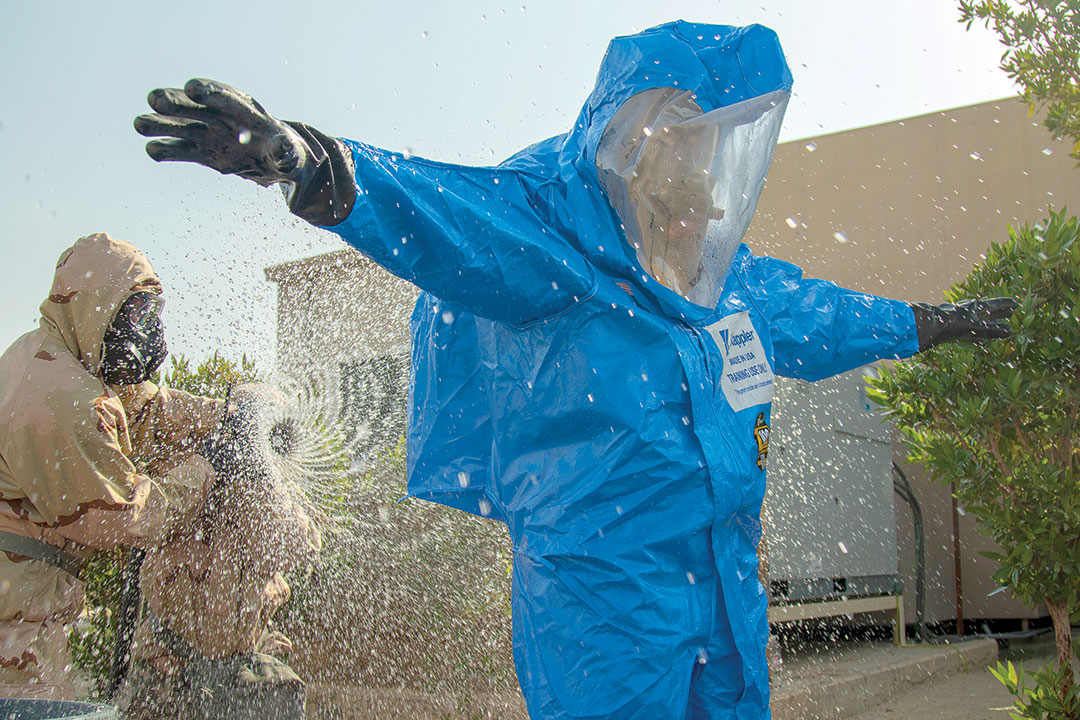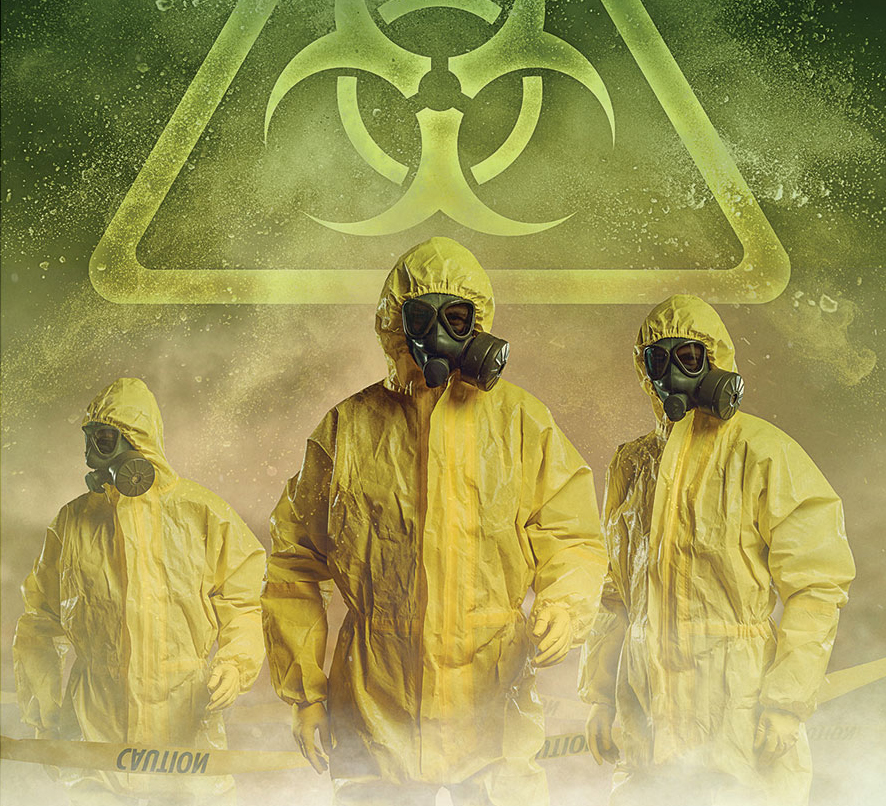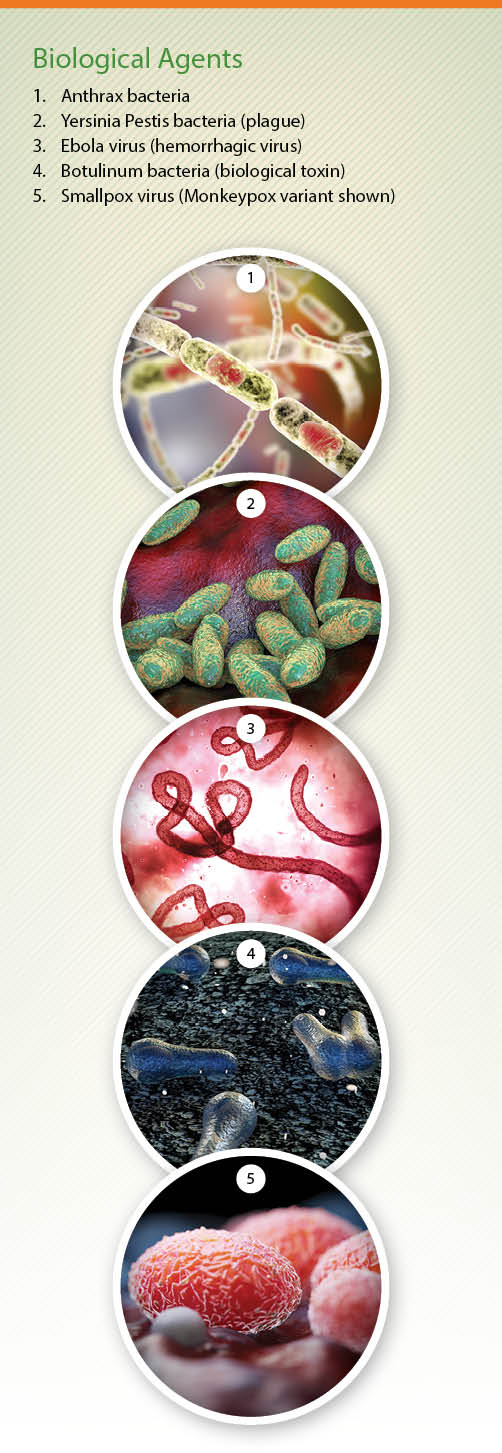Bioterrorism refers to the use of microorganisms or biological products as a means of terrorizing and causing harm. This type of terrorism is characterized by its ability to cause widespread fear and destruction while making it difficult to trace the source of the attack and identify those responsible. Bioterrorism differs from other types of terrorism in several respects:
Nature of agent: Microscopic organisms or their toxins are used, while conventional terrorism relies on conventional weapons such as bombs and firearms.
Method of spread: Biological agents can be spread in different ways, such as air, water or food, and symptoms of infection may take time to appear.
Long-term effects: Biological weapons may cause
harm to human health and the environment.
Difficulty in detection and diagnosis: A biological attack may be hard to recognize initially and diagnose quickly, making a response to it more complex.
Fear and panic: Biological attacks, by creating uncertainty, are capable of inciting high levels
of fear and anxiety among the public.
Nations increasingly recognize the threat posed by biological weapons, especially after the end of the Cold War and the spread of biotechnology. During the 1990s, there were disturbing incidents, such as the Aum Shinrikyo sect attacks in Japan, which used poisonous gases and tried to use anthrax as a weapon.

SGT. DAVID CAMPOS-CONTRERAS/U.S. ARMY
The attacks on September 11, 2001, raised the specter of terrorists using biological weapons. Soon afterward, the United States experienced mailed anthrax attacks, which sparked panic and led to raised biosecurity measures. Recently, concerns have grown over the development of biotechnology that could make it easier for terrorists to develop more lethal and efficient biological weapons. With advances in fields such as genetic engineering and synthetic biology, it is becoming more difficult to prevent biological outbreaks.
The rapid spread in technology goes side by side with enhanced awareness and preparedness at national and international levels, with tightened controls on biological materials and the development of strategies to address biological threats. Bioterrorism, however, remains a potential threat that requires continued vigilance and international cooperation.
Biological agents that terrorists could use include bacteria, viruses and toxins, each of which can cause different diseases. Here are some key examples:
Anthrax: Caused by the bacteria Bacillus anthraci, it can be transmitted by inhalation, skin contact or ingestion; inhalation is the most dangerous, as it can quickly lead to death without any possibility of early treatment.
Plague: Caused by Yersinia Pestis bacteria, it can be transmitted through animals or air droplets and has three forms: bubonic plague (the deadliest), pneumonic plague and cutaneous plague.
Hemorrhagic viruses (such as Ebola): These cause severe bleeding and have high mortality rates. They spread through contact with bodily fluids and represent a major challenge in bringing them under control due to their rapid transmission.
Biological toxins (such as botulinum): Botulinum toxin is considered one of the most powerful natural toxins known, and even small amounts can be fatal. It affects the nervous system and can cause paralysis.
Smallpox: This highly contagious virus has been almost eradicated but remains a concern as a biological weapon because of its high mortality rate and rapid spread.
The risk of bioterrorism grows as advances in technology and easy access to information bring more lethal opportunities for terrorists. A weak security environment can lead to inadequate control over biological materials and can make it easier for terrorist groups to obtain such materials.
Countries facing political unrest or conflict are more vulnerable to risks resulting from the use of biological weapons, while countries with weak health systems may find it difficult to deal effectively with biological attacks. Globalization and international mobility have also increased the risk of the spread of diseases and biological agents across national borders. Tensions among states or nonstate groups may lead some to resort to biological weapons.
Strategies do exist to reduce risks from biological attacks by terrorist groups. First, states must cooperate at the international level to exchange information and expertise and develop joint policies to combat bioterrorism.
Intelligence gathering efforts should be strengthened to detect possible biological weapons-related activities of terrorist groups.
Technological and scientific capabilities related to detecting and combating biological attacks must also be improved, such as developing rapid detection and analysis techniques of biological samples.
Medical and security personnel — and the public as a whole — should be made aware of the dangers of bioterrorism. They must be trained to recognize early symptoms of infectious diseases and take proper action in an emergency. That also means strengthening health infrastructure and medical laboratories to deal with cases associated with biological attacks.

CPL. JOSEPH BLACK/U.S. ARMY
Governments should partner with the private sector, such as pharmaceutical companies and medical labs, to exchange information and develop the technology and capabilities needed to combat bioterrorism.
Governments also need to develop strict policies and laws to combat bioterrorism and criminalize related activities. That includes cooperation with international agencies such as the World Health Organization and the United Nations to exchange information and experiences and develop joint strategies to combat bioterrorism.
States must implement strict procedures to monitor movement of chemical and biological materials, inspect them and verify their legitimate use.
If an attack seems imminent, states must be prepared to intervene rapidly. They must focus on equipment and training before the worst occurs and provide a system of communication and crisis management for the public and institutions. Prevention is also important.
These are some general strategies that can be taken to address bioterrorism risks. However, the focus should be on implementing specific strategies that are compatible with each region or country.
Conclusion
It’s clear that bioterrorism is a serious threat to global security as a whole, with its wide potential to cause severe damage to humans and the environment alike.
Studies and research in this field highlight the urgent need to strengthen joint international efforts to confront this threat, develop security and health systems, and improve mechanisms for early detection and immediate response to any threats arising from use of biological agents.
International legislation and agreements approved in this context also must reflect an international community keenness to provide a legal and ethical framework that limits the possibility of using biological weapons and sets strict controls to prevent their spread.
The challenge remains in achieving a balance between scientific and research freedoms and the need for security and risk prevention. An effective response to bioterrorism requires broad cooperation among various sectors, including public health, national security agencies, scientific research and international diplomacy. Countries must develop and implement comprehensive strategies covering prevention, detection, rapid response and recovery from biological attacks.
Education and awareness also play vital roles in strengthening the home front against bioterrorism. Educating people about the threat of biological weapons and how to respond in emergencies can make a big difference in reducing harm and saving lives.
In addition, countries must invest in research and development to find effective vaccines and treatments against biological diseases, reducing the devastating effects of any potential attack. It is also necessary to establish strong monitoring and surveillance systems to identify and follow up on infectious diseases, which is an essential step in early detection and prevention of the spread of diseases, if they are used as weapons.
Finally, international cooperation is a cornerstone of the fight against bioterrorism. Countries must work together to share information and strengthen international laws that target the spread of biological weapons. Effective diplomacy and long-term commitment are required from all parties to ensure a safer world.
A version of this article was published in Saudi Arabia by the Islamic Military Counter Terrorism Coalition.


